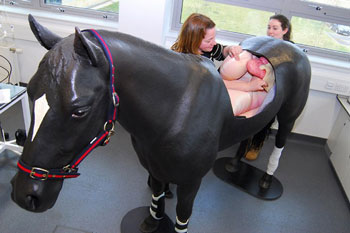
Equine model aids veterinary teaching
Vet students will be better prepared to tackle a common condition in horses by practising on the first life-size equine model of its kind in the UK.
The anatomical model will enable students at the University of Edinburgh to improve their diagnosis of colic, which affects many horses during their lifetime and can be life-threatening.
EQUINE SIMULATOR
The equine simulator at the Royal (Dick) School of Veterinary Studies contains large intestines and other organs made of latex.
These can be inflated to different degrees to help familiarise students with the condition.
The model, which was recently developed by Veterinary Simulator Industries in close collaboration with Dr. Emma Read of the University of Calgary, has been imported from Canada.
COLIC
Colic causes abdominal pain and is a leading cause of premature death in horses.
The simulator enables students to practice performing internal examination of a horse's intestines and sampling for free fluid in the abdomen.
It also has the potential to help students develop their ability to identify reproductive problems in mares.
The simulator was recently purchased, along with other animal teaching models through the School’s Jeanne Marchig International Centre for Animal Welfare Education.
The Centre, which forms an integral part of the University’s Royal (Dick) School of Veterinary Studies, was established in 2011 through a £2 million donation from the Marchig Animal Welfare Trust to improve the well-being of animals worldwide.
This includes seeking alternatives to the use of animals in teaching and research.
TEACHING MODELS
Animal alternatives for teaching include canine simulators on which students can practice intravenous injections and identify irregular heart sounds.
Specially designed models also enable students to practise suturing skin, intubation and neutering techniques.
Students can also carry out examinations on a cow simulator to help learn how to detect different stages of pregnancy and other reproductive conditions.
According to Dr. Catriona Bell
Senior Lecturer in Veterinary Education at the Royal (Dick) School of Veterinary Studies “the realistic attributes of these models will allow students to learn and then refine their basic dexterity and practical skills before undertaking the procedures on live animals. This is not only safer and less stressful for the students, but is also importantly a more welfare-friendly way of learning”
She added that the simulator can also be used to practise other clinical skills such as suturing wounds on horse legs “and we may adapt it in the future to allow students to learn how to take a blood sample or give an intravenous injection into the jugular vein in the horse's neck”.
